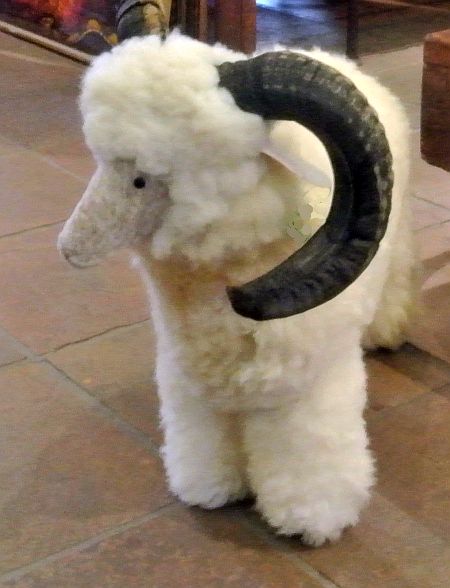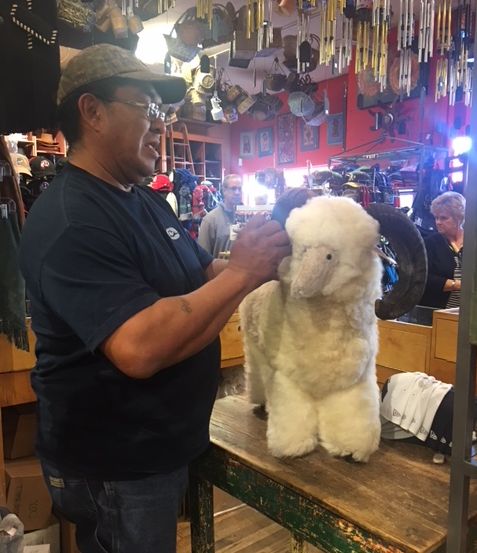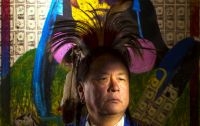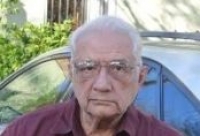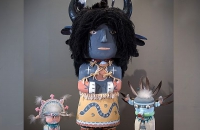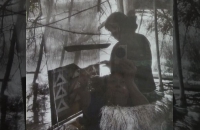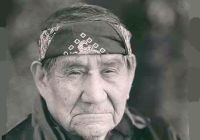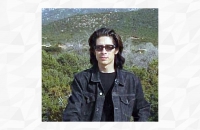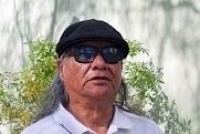C631 Big Horn Sheep by Navajo artist Ray Growler.
32" x 24" x 10"
The way Ray Growler tells the story he was the first artist to begin making sheep. He says he was working on his parent's house and needed some sawhorses. As he was out in the yard building them, a few sheep were milling about. Ray says he looked up from the sawhorse to a sheep and suddenly got the idea of putting the two together. His mother had a sheep pelt curing on the clothesline and Ray took it and secured it to the sawhorse. "It looked so good I took it to (a nearby trading post), and the trader said, 'great!', and put me to work."
A Ray Growler goat is in the Smithsonian Collection in Washington D.C..
Call for Shipping
About the artist
Ray Growler
RAY GROWLER
(Navajo 1965 – present)
Ray Growler - Goats & Sheep: Some of the animals are life size, and they look so real you almost expect them to nibble at you while standing next to them. These are the goats and sheep- and sometimes even miniature buffalo or llamas- that Ray Growler crafts from aspen wood and cured animal skins. Ray was one of the first two known folk artists to begin making the animals and he has always been the best. He is also the best known, although others have copied him. "I don't like to compare someone else's work to mine", Ray insists. "I just think about how to make mine and how it's going to represent me."
His work represents him well, winning prestigious awards at Santa Fe, Flagstaff, and the Gallup Ceremonials.
The way Ray Growler tells the story he was the first artist to begin making sheep. He says he was working on his parent's house and needed some sawhorses. As he was out in the yard building them, a few sheep were milling about. Ray says he looked up from the sawhorse to a sheep and suddenly got the idea of putting the two together. His mother had a sheep pelt curing on the clothesline and Ray took it and secured it to the sawhorse. "It looked so good I took it to (a nearby trading post), and the trader said, 'great!', and put me to work."
Another couple began making similar renditions about the same time, but they quit after a couple of years. Ray has not only maintained his craft over the past decade, he has gradually improved, so that now his animals have great detail and motion.
Ray uses dry aspen wood because it is lightweight. He roughs out the form then carves the limbs and head and attaches them to the body. Next come horns, if they are to be used, (and they usually are, as Ray likes making rams best). Then Ray attaches the cleaned and cured skins- which he cures himself-and then the eyes, nostrils, and ears.
"People come from all over the world to see me and buy goats from me," Ray says, not without a hint of wonder in his voice.
If it is a marvel to him, it is not to those who see his work. His animals don't just stand there, they are frozen in motion. He has made rams locked in battle; or sheep in mid-step. His animals’ heads are turned just so and have endearing expressions. They are much more attractive than their living counterparts.
Born in Sweetwater, New Mexico, Ray was not raised traditionally, but has an interest in his culture and has learned much from his uncle, Emmerson Brady, who is a medicine man. "He taught me how to represent myself in a Navajo Way and tell who I am and about my clans," Ray says. He believes these things are important to know and asks his uncle many questions. He has also asked for Peyoteway and Beautyway Ceremonies, or a Squaw Dance to help him recover needed mental and physical health, and to regain his artistic focus.
Ray has had requests to do other animals, and occasionally creates commissioned pieces. Someone once asked him to do a polar bear, but this is one animal Ray will not make. It is dangerous in Navajo tradition to try and replicate the powerful bear.
A sheet metal worker by trade, Ray cannot always find employment, and so he depends on income from his folk craft to support his family. "And," he admits, acknowledging his growing fame, "it's nice to be known for something."


